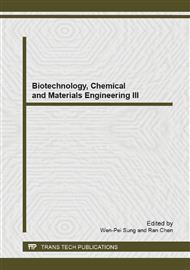[1]
Bi Yuyun, Gao Chunyu, Wang Yajing, et al: Estimation of straw resources in China. Transactions of the CSAE vol. 25(12) (2009), pp.211-217.
Google Scholar
[2]
S. Panthapulakkal, A. Zereshkian, M. Sain. Preparation and characterization of wheat straw fibers for reinforching application in injection molded thermoplastic composites[J]. Bioresource Technology vol. 97(2)(2006), 265-272.
DOI: 10.1016/j.biortech.2005.02.043
Google Scholar
[3]
Hornsby, P.R., Hinrichsen, E., Trivedi, K. Preparation and properties of polypropylene composites reinforced with wheat and flax straw fibers, Part 2, Analysis of composite microstructure and mechanical properties.J. Mater. Sci. vol. 32(4)(1997).
Google Scholar
[4]
P.K. Ghosh, Devi Dayal, K.K. Bandyopadhyay et al. Evaluation of straw and polythene mulch for enhancing productivity of irrigated summer groundnut. Field. Crop. Res., vol. 99(s2-3)(2006), 76-86.
DOI: 10.1016/j.fcr.2006.03.004
Google Scholar
[5]
Prasad B.M., Sain ,M. Mechanical properties of thermally treated hemp fibers in inert atmosphere for potential composite reinforcement. Mater. Res. Innovations, vol. 7(4)(2003), 231-238.
DOI: 10.1007/s10019-003-0258-y
Google Scholar
[6]
ZhouWen-chun. Research and development of environmentally friendly hemp fiber film paper analysis. Chinese Fiber Plant Fiber and products, Vol. 24(2002), p.22–24.
Google Scholar
[7]
Quangling Yang, Ang Lue, Lina Zhang. Reinforcement of ramie fiber on regenerated cellulose films. Composites Science and Technology, Vol. 70(2010), pp.2319-2324.
DOI: 10.1016/j.compscitech.2010.09.012
Google Scholar
[8]
Hornsby, P.R., Hinrichsen, E., Trivedi, K. Preparation and properties of polypropylene composites reinforced with wheat and flax straw fibers, Part 2, Analysis of composite microstructure and mechanical properties. J. Mater. Sci., Vol. 32 (1997).
Google Scholar
[9]
Sun Qing, Yi Weiming, Gu Shiyan et al. Study on Isolation of Cellulose-decomposing Microorganisms and Its Cellulase-producing Conditions. Transactions of the Chinese Society for Agricultural Machinery, Vol. 41 (2010), pp.141-144.
Google Scholar
[10]
Liu Lixue. Chen Haitao. Han Yongjun. Determination and analysis of physical characteristics and fiber chemical composition of biogas residue. Transactions of the CSAE vol26 (2010), pp.277-280.
Google Scholar
[11]
Han Yongjun, Chen Haitao, Liu Lixue, et al. Optimization of technical parameters for preparing fiber from rice straw. Transactions of the CSAE, Vol. 27 (2011), pp.281-286.
Google Scholar
[12]
Huang Ying-hua. Tian Xin. In addition to corn stalk pulp TCF bleaching pulp and paper, HEILONGJIANG PULP& PAPER (2007), pp.28-29.
Google Scholar


